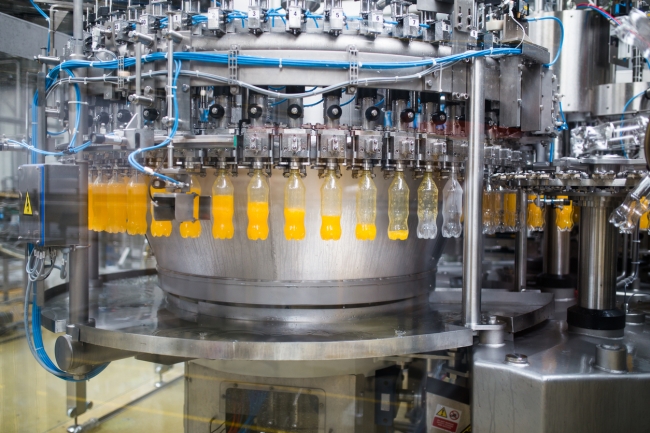4 minute read • published in partnership with Cimlogic
Insight: How much product (and profit) are you giving away?
Giveaway is defined as “a thing that is given free, often for promotional purposes”. So why do so many manufacturers seem content to give away large chunks of profit without any promotional benefit whatsoever? Cimlogic explores the reasons for reducing giveaway and how to quantify potential savings.
In any production environment where products are being filled into bottles/packages according to stated volumes/weights, there is a risk of error. Underfilled packages risk violating the Weights and Measures (Packaged Goods) Regulations 2006, with negative consequences for the manufacturer, both financially (with subsequent fines etc) and from a PR perspective (the social media curse!). “Tesco withdraws £93,000 worth of underweight garlic bread” and “Lanchester Dairies fined for underfilling milk cartons” are just two FMCG examples.
To avoid such headlines, manufacturers typically adopt an ‘overfill’ strategy. The financial impacts of this can be even more significant, but companies may not take the time to evaluate the result of eg 1% overfill on annual business profits. The potential savings to be achieved from a simple 1% reduction in overfill can run into £1,000,000s for large manufacturing companies. Controlled overfill can provide protection from fines and ensure strict adherence to legislation. Uncontrolled overfill, however, can far exceed the cost of non-compliance.

Many manufacturers might be sceptical of the potential for reducing giveaway on their packaging lines, but at the very least should undertake analysis to understand their options / Picture: Getty/iStock
What rules do manufacturers need to adhere to?
Under the average weight system, packers are responsible for adhering to the ‘Three Packers Rules’*. These set out 3 rules that packers and importers must comply with:
• the contents of the packages must not be less on average than the nominal quantity
• the proportion of packages which are short of the stated quantity by more than a defined amount (the ‘tolerable negative error’) should be less than a specified level
• no package should be short by twice the tolerable negative error
These provide protection for consumers on short measure. It all seems fair, so why is this an area where manufacturers seem intent on ‘overachieving’ against the defined targets, giving excess product to the consumer without getting remunerated for their generosity?
Organisations typically want to mitigate against three potential risks:
1 – Underfilled products resulting in production delays (and potential reruns) or, if discovered only at point of sale, leading to product recall and significant losses (both financial and to a company brand).
2 – Uncontrolled fill variations (through lack of monitoring and control procedures) requiring additional work to minimise negative impacts.
3 – Overfilled packages leading to excess giveaway.
Minimising fill variation not only reduces the amount of product giveaway, but can also reduce material costs in packaging, storage and transportation.
So, how can you comply with the regulations but still reduce costs?
Some manufacturers may be unaware of technologies now available to capture information quickly and easily using IIoT, allowing the relevant fill weight information to be analysed in real time, and overfill/underfill issues to be addressed easily. Others simply do not see it as an issue (the ‘we’ve always done it this way’ mentality), and Finance Directors are kept in the dark about potential production savings on the plant floor being not only an option, but easily achievable. Overfill is often seen as a necessary cost of legal compliance.
Measuring and controlling overfill can significantly reduce production costs. Many companies tackling the problem of fill variation face the challenge of lack of historical data from production lines. Data-driven solutions are key to the identification of root causes of variation and to implement effective solutions. Lean Six Sigma projects can focus on reducing internal waste and addressing process variations. Statistical Process Control (SPC) analysis is then used to reduce fill variation and realise significant cost savings, whilst ensuring compliance with current legislation.
Such systems need not be complex, and the potential savings far outweigh the implementation cost. Leading FMCG manufacturers ensure they have procedures in place to reduce cost (and increase profit) by reducing giveaway:
• Collect production data in real-time, allowing accurate analysis
• Set up continuous reporting systems allowing visual reporting of trends
• Stipulate appropriate target quantities and schedule alerts for variations
• Use and maintain appropriate checking equipment
• Use continuous improvement tools to monitor giveaway in real-time and implement processes to reduce it to an acceptable level.
Where to start?
Many manufacturers might be sceptical of the potential for reducing giveaway on their packaging lines, but at the very least should undertake analysis to understand their options. A short analysis of production data can identify areas for improvement and quantify potential savings. What would a 1% reduction in overfill mean to your organisation?
If you would like to learn more about how to reduce giveaway in your organisation watch our on-demand webinar ‘Reduce product giveaway in 4 simple steps’ or sign up for the Giveaway Analysis Report.
